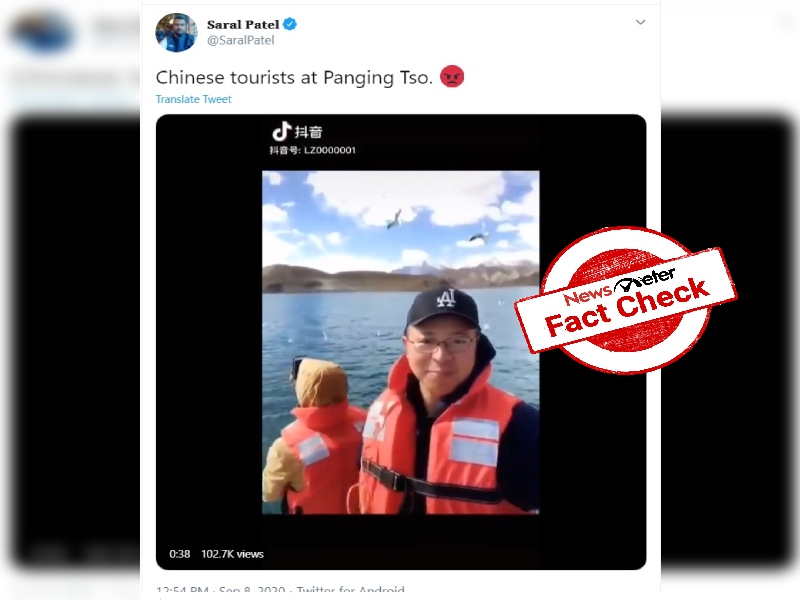Fact Check: Video of Chinese tourists at Pangong Tso lake shared with misleading claims
By Satya Priya BN
Hyderabad: On the night of 28 August, China attempted to move in over 1,000 soldiers to capture territory on the Indian side of the Line of Actual Control, near the southern bank of Pangong Tso. However, the attempt was thwarted by the Indian Army. In a statement, the Army said the Chinese troops "violated the previous consensus arrived at during military and diplomatic engagements during the ongoing standoff in Eastern Ladakh and carried out provocative military movements to change the status quo".
However, a few videos reportedly showing some Chinese tourists in Pangong Tso lake has gone viral.
A Twitter user, Saral Patel, shared the video and tweeted, "Chinese tourists at Panging Tso (sic)."
Another user shared the same video and wrote, "Hey @narendramodi what are u doing still as @PMOIndia Enough of having fun in satisfying your weakness! Stop eating Mushrooms which gives u so much of strength in tat __mood always! Look at Chinese Tourists at Our Land Panging Tso @INCIndia Alert (sic)."
The video and the claim have also gone viral on Facebook. One Facebook user shared the video and wrote, "Chinese tourists in Ladakh's Pangong Lake. Can someone ask '56 inch' Chowkidar if we now need a visa to visit Pangong Lake? (sic).
Archived links can be found here, here and here.
Fact Check:
The claim is MISLEADING. India and China share the lake and the national boundaries cut through the lake. Sixty per cent of the 550 km square lake falls in Tibet (China). The lake stretches for nearly 130 km, while the width is anywhere between two-six km. As the lake is shared by two countries, tourists are allowed only till Spagmik village.
Pangong Tso Lake is situated in the Himalayas at an elevation of over 4,000 m above sea level. The lake is 160 km away from Leh-Ladakh in Jammu and Kashmir. Pangong Tso which means 'high grassland lake' in Tibetan is said to derive its name from the Tibetan word 'Banggong Co' meaning 'an enchanted, long, narrow lake'.
Pangong Tso lake is an endorheic lake (landlocked) that is partly in India's Ladakh region and partly in Tibet (occupied by China). The name reflects the mixed heritage of the lake: Pangong in Ladakhi means extensive concavity, the word Tso is Tibetan for the lake.
The lake's water, while crystal clear, is brackish, making it undrinkable. The lake freezes during the winter, allowing some vehicular movement. But India and China have unsettled borders, and the perception of the LAC differs in multiple sectors, including on Pangong Tso.
According to Indian statistics, at the lake's north bank, the international boundary is close to Khurnak Fort, a 19th-century ruin. But the LAC is around 15 km west. On the north bank are spurs that jut into the lake, identified as fingers. India says the LAC passes through Finger 8; China claims it is farther west.
Compared to the north bank, the difference in perception of the LAC is not very wide in the south bank. A former brigade commander from the region said the perception may differ by 100 to 200 m, and lacks prominent features like fingers.
These "differing perceptions of the LAC", as the Army has called it, are one of the main causes of the face-offs.
Amid the ongoing border standoff between Indian and Chinese soldiers in Ladakh, a video was shared by unverified Twitter users claiming that China will facilitate the return of international tourists to Pangong Tso. Later, it was alleged that the video was a propaganda exercise by Beijing as it featured a Chinese national and the narration was in Mandarin.
Here is the Chinese video about Pangong Tso:
The release of the video by China has been reported by several media outlets.
According to Times Now, China is disseminating videos showing the opening of Pangong Tso lake on the Chinese side to international tourists.
According to tfipost.com, "In a desperate effort to save face, China indulged in a PR exercise; the official handles of the Chinese Communist Party machinery are disseminating videos of opening Pangong Tso Lake to the international tourists on the Chinese side."
The video released by the Chinese and the viral video are similar and definitely shows Pangong Tso lake. But, a large portion of the lake is in China. So, the claim that Chinese tourists are entering the Indian side of the lake is MISLEADING.